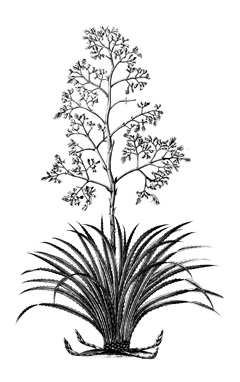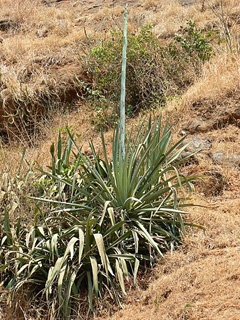 |
|
https://edibleplants.org/ |
 |
| Dinesh Valke wikimedia.org |
Translate this page:
Summary
Agave: Agave cantala.
Commonly grown in Southeast Asia from the Philippines to India, Agave (Agave cantala) is, a succulent, evergreen, perennial plant that forms a rosette of leaves that grows up to 2 m long. It forms a flowering stem of up to 8 m in height towards the end of its life. The shoot buds are cooked and eaten as a vegetable. It is often used in landscaping as hedgerows and along rivers and brooks for reducing soil erosion. The leaves are great source of fibre used for making baskets, mats, ropes, hammocks, sandals, fishing nets, bags, and harvest binding strings. The roots, on the other hand, can be of great source of saponins that can be used as substitute for soap.
Physical Characteristics

 Agave cantala agave is an evergreen Perennial growing to 2 m (6ft) by 2 m (6ft) at a fast rate.
Agave cantala agave is an evergreen Perennial growing to 2 m (6ft) by 2 m (6ft) at a fast rate.
See above for USDA hardiness. It is hardy to UK zone 10 and is frost tender.
Suitable for: light (sandy), medium (loamy) and heavy (clay) soils, prefers well-drained soil and can grow in nutritionally poor soil. Suitable pH: mildly acid, neutral and basic (mildly alkaline) soils. It cannot grow in the shade. It prefers dry or moist soil and can tolerate drought.
UK Hardiness Map
US Hardiness Map
Synonyms
Furcraea cantala Haw.
Plant Habitats
Edible Uses
Edible Parts: Shoots Stem
Edible Uses:
Shoot buds - cooked and eaten as a vegetable[317
].
References More on Edible Uses
Medicinal Uses
Plants For A Future can not take any responsibility for any adverse effects from the use of plants. Always seek advice from a professional before using a plant medicinally.
None known
References More on Medicinal Uses
The Bookshop: Edible Plant Books
Our Latest books on Perennial Plants For Food Forests and Permaculture Gardens in paperback or digital formats.

Edible Tropical Plants
Food Forest Plants for Hotter Conditions: 250+ Plants For Tropical Food Forests & Permaculture Gardens.
More

Edible Temperate Plants
Plants for Your Food Forest: 500 Plants for Temperate Food Forests & Permaculture Gardens.
More

More Books
PFAF have eight books available in paperback and digital formats. Browse the shop for more information.
Shop Now
Other Uses
Other uses rating: High (4/5). Agroforestry Uses: Often planted as a hedge along the roadsides and in gardens, it is also used for reducing soil erosion along rivers and brooks[ 317 , 418 ]. Other Uses A fibre is obtained from the leaves[ 317 , 418 ]. It is mainly used for baskets, mats, fishing-nets, ropes, harvest binding strings, hammocks, bags and sandals[ 317 , 418 ]. The fibre is finer but less strong than that of sisal (Agave sisalana) and henequen (Agave fourcroydes)[ 418 ]. It is more suitable for spinning than that of sisal[ 317 ]. Wrapping paper is produced from the remainders[ 317 ]. The roots contain saponins and can be used as a soap substitute[ 331 ].
Special Uses
Carbon Farming
References More on Other Uses
Cultivation details
Agroforestry Services: Living fence Industrial Crop: Fiber Regional Crop Staple Crop: Basic Starch
A plant of the drier tropics. It grows best in areas where annual daytime temperatures are within the range 17 - 30c, but can tolerate 10 - 38c[ 418 ]. It is able to withstand occasional temperatures down to at least -4?c, so long as the weather and soil are fairly dry[ 423 ]. It prefers a mean annual rainfall in the range 1,000 - 2,000mm, but tolerates 400 - 2,700mm[ 418 ]. Requires a sunny position in a well-drained soil. Prefers a pH in the range 6.5 - 7.5, tolerating 6 - 8[ 418 ]. The leaves contain about 4% fibre and yields of clean fibre vary between 1.1 - 3 tonnes per hectare[ 418 ]. A monocarpic species - the plant lives for a number of years without flowering but dies once it does flower. However, it normally produces plenty of suckers during its life and these continue growing, taking about 10 - 15 years in a warm climate, considerably longer in colder ones, before flowering[ 11 ]. The plant has a lifespan of more than 15 - 30 years[ 418 ].
Carbon Farming
-
Agroforestry Services: Living fence
Simply managed rows of shrubs and trees.
-
Industrial Crop: Fiber
Clothing, rugs, sheets, blankets etc. Currently, almost none of our fiber are produced from perennial crops but could be!
-
Regional Crop
These crops have been domesticated and cultivated regionally but have not been adopted elsewhere and are typically not traded globally, Examples in this broad category include perennial cottons and many nuts and staple fruits.
-
Staple Crop: Basic Starch
The Carbon Farming Solution. Eric Toensmeier.
References Carbon Farming Information and Carbon Sequestration Information
Temperature Converter
Type a value in the Celsius field to convert the value to Fahrenheit:
Fahrenheit:
The PFAF Bookshop
Plants For A Future have a number of books available in paperback and digital form. Book titles include Edible Plants, Edible Perennials, Edible Trees,Edible Shrubs, Woodland Gardening, and Temperate Food Forest Plants. Our new book is Food Forest Plants For Hotter Conditions (Tropical and Sub-Tropical).
Shop Now
Plant Propagation
Seed - Allow pods to dry on plant; break open to collect seeds
Other Names
If available other names are mentioned here
Agave: Agave cantala.
Native Range
Coming Soon
Weed Potential
Right plant wrong place. We are currently updating this section.
Please note that a plant may be invasive in one area but may not in your area so it's worth checking.
None known
Conservation Status
IUCN Red List of Threatened Plants Status : This taxon has not yet been assessed.

Growth: S = slow M = medium F = fast. Soil: L = light (sandy) M = medium H = heavy (clay). pH: A = acid N = neutral B = basic (alkaline). Shade: F = full shade S = semi-shade N = no shade. Moisture: D = dry M = Moist We = wet Wa = water.
Now available:
Food Forest Plants for Mediterranean Conditions
350+ Perennial Plants For Mediterranean and Drier Food Forests and Permaculture Gardens.
[Paperback and eBook]
This is the third in Plants For A Future's series of plant guides for food forests tailored to
specific climate zones. Following volumes on temperate and tropical ecosystems, this book focuses
on species suited to Mediterranean conditions—regions with hot, dry summers and cool, wet winters,
often facing the added challenge of climate change.
Read More
Expert comment
Author
(Haw.) Roxb. ex Salm-Dyck
Botanical References
Links / References
For a list of references used on this page please go here
A special thanks to Ken Fern for some of the information used on this page.
Readers comment
| Add a comment |
|
If you have important information about this plant that may help other users please add a comment or link below. Only comments or links that are felt to be directly relevant to a plant will be included. If you think a comment/link or information contained on this page is inaccurate or misleading we would welcome your feedback at [email protected]. If you have questions about a plant please use the Forum on this website as we do not have the resources to answer questions ourselves.
* Please note: the comments by website users are not necessarily those held by PFAF and may give misleading or inaccurate information.
To leave a comment please Register or login here All comments need to be approved so will not appear immediately.
|
Subject : Agave cantala agave
|
|
|
|